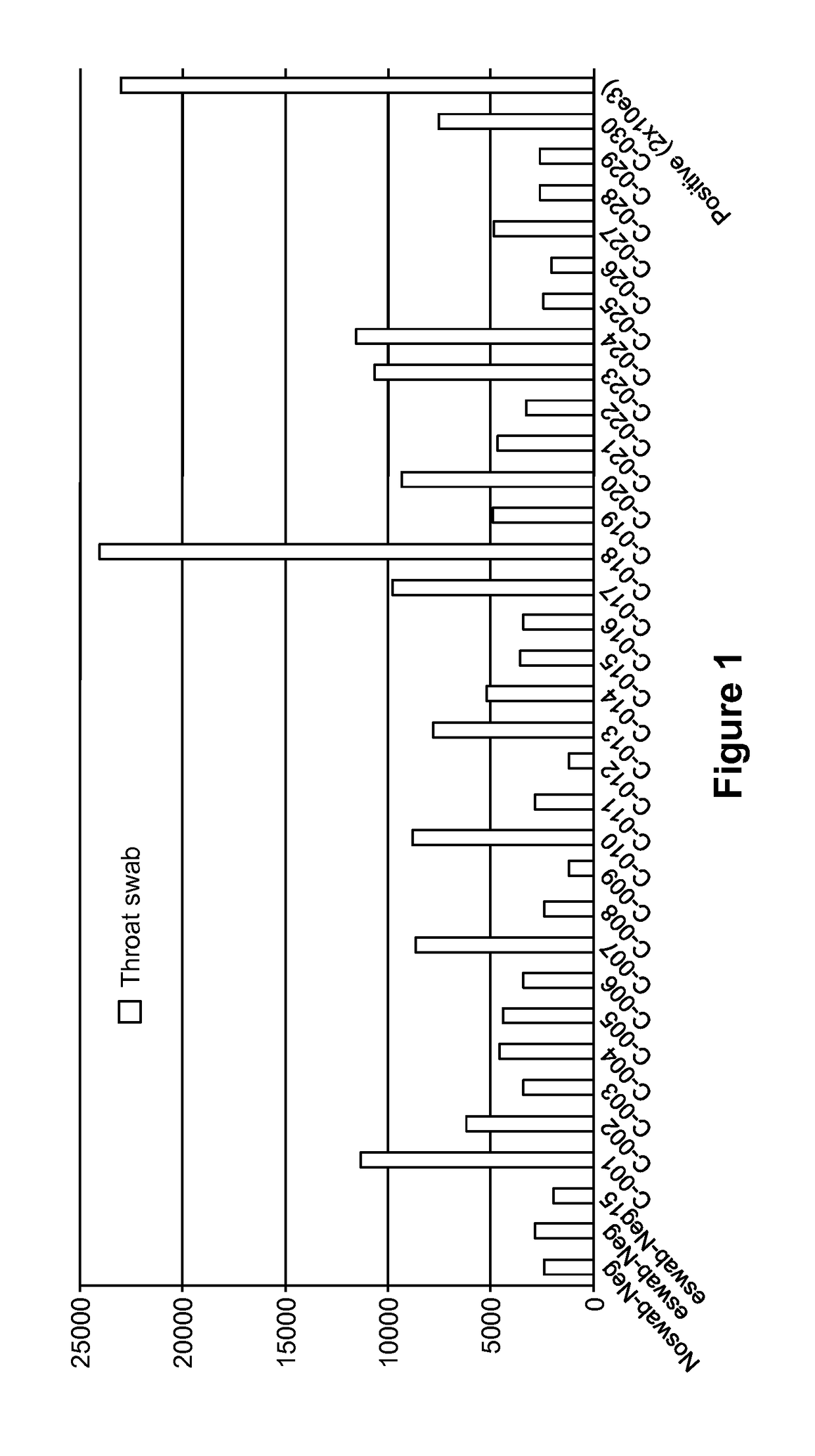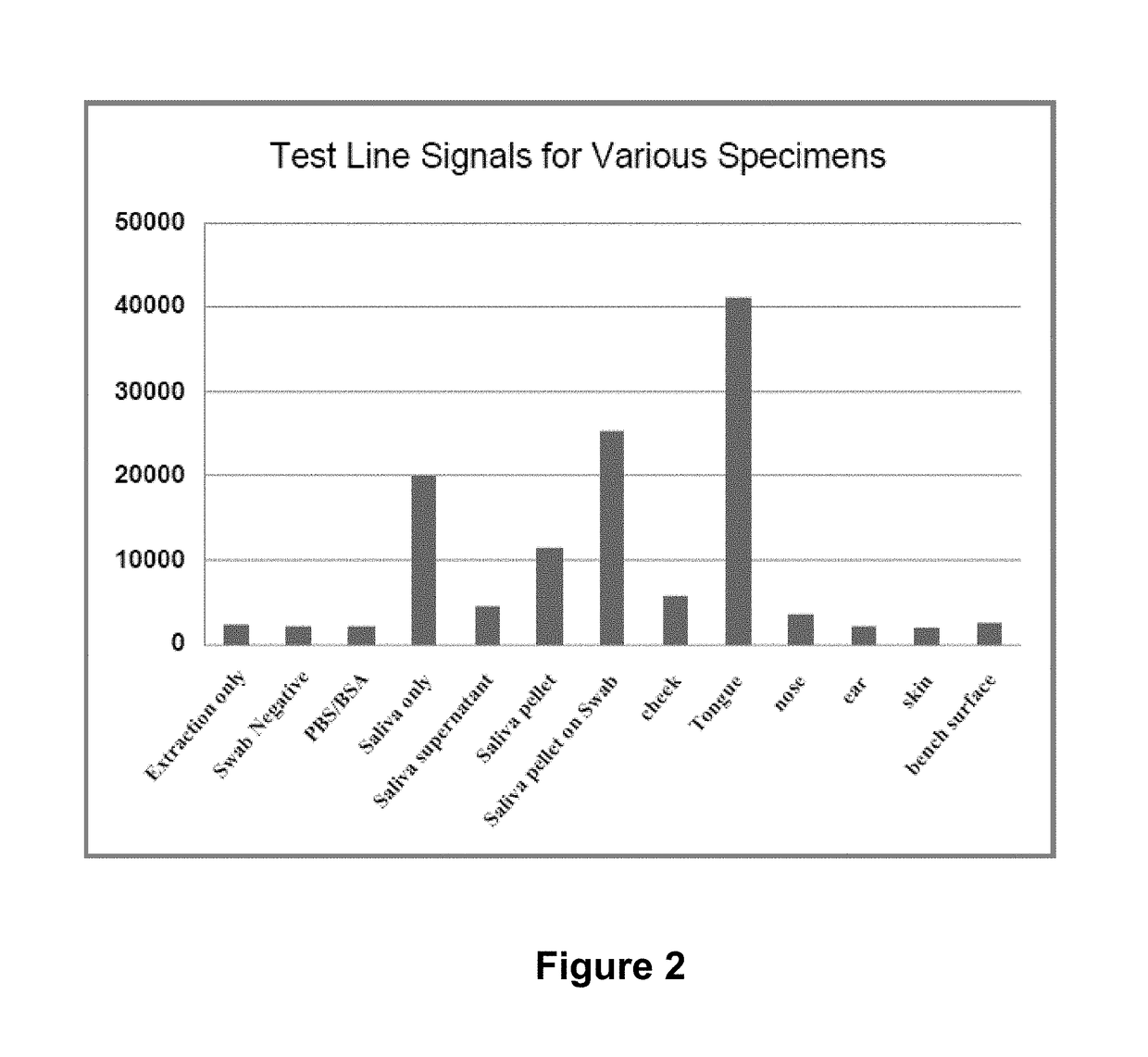N-acetyl-D-glucosamine for enhanced specificity of Strep A immunoassay
a technology of strep and immunoassay, applied in the field of diagnostics, can solve the problems of high false positive rate, complex surface of strep, chemically diverse, etc., and achieve the effect of reducing the false positive ra
- Summary
- Abstract
- Description
- Claims
- Application Information
AI Technical Summary
Benefits of technology
Problems solved by technology
Method used
Image
Examples
example 1
ng Saliva Samples from Healthy Volunteers
[0130]Saliva specimens were collected from thirty (30) healthy donors. As a positive control a quality control (QC) standard for Strep A consisting of a known number of antigens was obtained. QC standards with 3.75×102 organisms / test, 3.75×104 organisms / test and 3.75×105 organisms / test were obtained. An aliquot of each saliva specimen was deposited on a lateral flow immunoassay test strip comprising similar to that shown in FIG. 5 and comprising polyclonal antibodies specific for Strep A antigen with a fluorescent label. A second aliquot of each saliva specimen was combined with a known quantity (2 mg / mL) of affinity purified polyclonal Strep A antibody. The saliva plus antibody samples were deposited on the immunoassay device, and the test line of the immunoassay device was visually observed for the presence of a fluorescent signal indicative of antigen. The results are shown in FIG. 3.
[0131]As seen in FIG. 3, some of the saliva specimens in...
example 2
of Saccharide Compounds on Observed False Positive Results
[0133]Compounds composed of or having structures similar to those in bacterial cell wall and human tissues were identified and selected for investigation for ability to inhibit generation of a positive signal on a strep A immunoassay test. The chemicals selected for study were N-acetyl-D-glucosamine (NAG), glucosamine, acetyl-galactosamine, galactosamine, mannosamine, acetyl-muramic acid, chitin, chitosan and hyaluronic acid (HA-50K).
[0134]In the study, tongue swab samples from a healthy human patient were obtained. A Strep A quality control standard (1×103 organisms / test) was also obtained for testing. The tongue swab sample and the QC standard sample were each treated with one of the test compounds and the sample was then deposited on an immunoassay device for detection of Strep A. As controls and comparators, the strep A QC standard and a tongue swab were each treated with the extraction reagents provided with the Strep A ...
example 3
onses of Nag on Positive and False Positive Signals
[0135]Six tongue swabs were taken from a healthy individual. A Strep A quality control (QC) standard with 2.0×103 organisms / test was obtained. The swabs and the QC standards were prepared for testing using an immunoassay device for detection of Strep A using polyclonal Strep A antibodies with a fluorescent label. Each sample was admixed with a reagent comprising NAG at 0.125 mg / mL, 0.25 mg / mL, 0.5 mg / mL, 1 mg / mL and 2 mg / mL. The samples were deposited on the immunoassay device, and the test line was visually observed using a fluorescence analyzer for the presence of a positive signal. Results are shown in FIG. 6 as a function of concentration of NAG present in the extraction reagent for tongue swab samples (diamonds) and for a Strep A quality control standard of 2×103 organisms / test (squares).
PUM
| Property | Measurement | Unit |
|---|---|---|
| concentrations | aaaaa | aaaaa |
| concentrations | aaaaa | aaaaa |
| concentrations | aaaaa | aaaaa |
Abstract
Description
Claims
Application Information
 Login to View More
Login to View More - R&D
- Intellectual Property
- Life Sciences
- Materials
- Tech Scout
- Unparalleled Data Quality
- Higher Quality Content
- 60% Fewer Hallucinations
Browse by: Latest US Patents, China's latest patents, Technical Efficacy Thesaurus, Application Domain, Technology Topic, Popular Technical Reports.
© 2025 PatSnap. All rights reserved.Legal|Privacy policy|Modern Slavery Act Transparency Statement|Sitemap|About US| Contact US: help@patsnap.com



